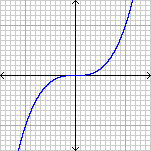鞍点c语言算法,鞍点
鞍点(Saddle point)在微分方程中,沿着某一方向是稳定的,另一条方向是不稳定的奇点,叫做鞍点。在泛函中,既不是极大值点也不是极小值点的临界点,叫做鞍点。在矩阵中,一个数在所在行中是最大值,在所在列中是最小值,则被称为鞍点。在物理上要广泛一些,指在一个方向是极大值,另一个方向是极小值的点。[1]
中文名
鞍点
外文名
Saddle point
广 义
一个光滑函数用 途
c语言
应用学科
数学
定 义
不是极大值也不是极小值的临界点
鞍点定义
编辑
图1 z=x2-y2的鞍点在(0,0)广义而说,一个光滑函数(曲线,曲面,或超曲面)的鞍点邻域的曲线,曲面,或超曲面,都位于这点的切线的不同边。
鞍点示例
编辑
参考图1,鞍点这词来自于不定二次型x^2-y^2的二维图形,像马鞍:x-轴方向往上曲,在y-轴方向往下曲。
检验二元是函数F(x,y)的驻点是不是鞍点的一个简单的方法,是计算函数在这个点的Hessian矩阵:如果黑塞矩阵的行列式小于0,则该点就是鞍点。[2]
函数在驻点(0,0)的黑塞矩阵是:
图2 y=x3的鞍点在(0,0)我们可以看到此矩阵有两个特征值2,-2。它的行列小于0,因此,这个点是鞍点。然而,这个条件只是充分条件,例如,对于函数z = x4 − y4,点(0,0)是一个鞍点,但函数在原点的黑塞矩阵是零矩阵,并不小于0。如图2,一维鞍点看起来并不像马鞍!在一维维空间里,鞍点是驻点.也是反曲点点。因为函数图形在鞍点由凸转凹,或由凹转凸,鞍点不是区域性极点。
鞍点应用
编辑
思考一个只有一个变数的函数。这函数在鞍点的一次导数等于零,二次导数换正负符号.例如,函数y=x^3就有一个鞍点在原点。[1]
两座山中间的鞍点(双纽线的交叉点)思考一个拥有两个以上变数的函数。它的曲面在鞍点好像一个马鞍,在某些方向往上曲,在其他方向往下曲。在一幅等高线图里,一般来说,当两个等高线圈圈相交叉的地点,就是鞍点。例如,两座山中间的山口就是一个鞍点。
鞍点C语言代码
编辑
#include "stdio.h"
#include "conio.h"
#include "malloc.h"
#define TRUE 1
#define FALSE 0
#define OK 0
#define ERROR 1
#define MAXX 80
void Print(int * const pMatrix, const int m, const int n);
void Input(const int * const pm, const int * const pn);
void CreatTureMatrix(int ** const pMatrix,int ** const pTrueMatrixconst, const int m, const int n);
OutPrint(int ** const pMatrix, int ** const pTrueMatrix, const int m, const int n );
int main(void)
{
system("cls");
{
const int m = FALSE, n = FALSE;
Input(&m, &n);
{
int * pMatrix = NULL, * pTrueMatrix = NULL;
CreatTureMatrix(&pMatrix, &pTrueMatrix, m, n);
printf("\nMatrix is :\n");
Print(pMatrix, m , n);
printf("\nSaddle point Ture Matrix is :\n");
Print(pTrueMatrix, m, n);
OutPrint(&pMatrix, &pTrueMatrix, m, n);
}
}
getch();
return (OK);
}
void Print(int * const pMatrix, const int m, const int n)
{
int * p = NULL;
for(p = pMatrix; p < pMatrix + m*n; ++p)
{
printf("%5d", *p);
if( !( (p - pMatrix)%n- (n-1) ) )
{printf("\n"); }
}
}
void Input(const int * const pm,const int * const pn)
{
printf("Please enter a matrix of rows, columns: ");
{
int flag = TRUE;
while(flag)
{
if(scanf("%d%d", pm, pn) - 2)
{
flag = TRUE;
printf("Worry enter,retry!\n");
fflush(stdin);
}
else if( (*pm<=0 || *pm>=10) && (*pn<=0) || (*pn>=10) )
{
flag = TRUE;
printf("Enter Big or small,retry!\n");
}
else
{flag = FALSE;}
}
}
}
void CreatTureMatrix(int ** const pMatrix,int ** const pTrueMatrix, const int m, const int n)
{
*pMatrix = (int *)malloc( m*n*sizeof(int) );
*pTrueMatrix = (int *)calloc( m*n,sizeof(int) );
{
int *p = NULL;
for(p = *pMatrix; p < *pMatrix + m*n; ++p)
{scanf("%d",p);}
}
{
int * p = NULL;
for(p = *pMatrix; p < *pMatrix + m*n; p += n)
{
int * pMaxj = p;
{
int * q = NULL;
for(q = p + 1; q < p + n; ++q)
{
if(*q > *pMaxj)
{pMaxj = q;}
}
}
{
int * q = NULL;
for(q = pMaxj; q < p + n; ++q) /*此处处理所有(不严格)最大值*/
{
if( !(*q - *pMaxj) )
{
int * r = NULL;
for(
r = *pMatrix + (q - *pMatrix)%n
;(r < *pMatrix + m*n) && (*r >= *pMaxj)
;r += n
);
if( r >= (*pMatrix + m*n) )
{*(*pTrueMatrix + (q - *pMatrix)) = 1; }
}
}
}
}
}
}
OutPrint(int ** const pMatrix, int ** const pTrueMatrix, const int m, const int n )
{
int count = 0;
int * p = NULL;
printf("\nSaddle point is :\n");
for(p = *pTrueMatrix; p < *pTrueMatrix + m*n; ++p)
{
if(*p)
{
printf("Matrix[%d][%d] = %3d, "
, (p - *pTrueMatrix)/n, (p - *pTrueMatrix)%n
, *(*pMatrix + (p - *pTrueMatrix)) );
++count;
}
}
free(*pMatrix);
*pMatrix = NULL;
free(*pTrueMatrix);
*pTrueMatrix = NULL;
if(count)
{
const int xPos = wherex(), yPos = wherey();
if(xPos - 1)
{gotoxy(xPos - 2, yPos); }
else
{gotoxy(MAXX - 1, yPos - 1); }
printf(".");
} /*此处TC一类特有的函数gotoxy()*/
else
{printf("It is not exist!\n"); }
}
词条图册
更多图册
参考资料
1.
Hilbert, David; Cohn-Vossen, Stephan, Geometry and the Imagination 2nd, New York: Chelsea, 1952, ISBN 978-0-8284-1087-8
2.
Gray,, Lawrence F.; Flanigan, Francis J.; Kazdan, Jerry L.; Frank, David H; Fristedt, Bert, Calculus two: linear and nonlinear functions, Berlin: Springer-Verlag: page 375, 1990, ISBN 0-387-97388-5


